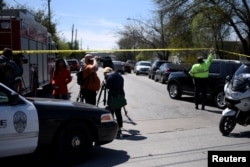If police in Austin, Texas, see a pattern in the three package bombs that have struck fear in the state's capital this month, they are not revealing it, insisting they do not know the motive or see a common thread among the victims.
As a consequence, residents of the three neighborhoods where the bombs exploded quickly filled the vacuum with theories of their own.
The first bombing on March 2 killed Anthony Stephan House, 39, a black man. A bomb Monday morning killed Draylen Mason, 17, also black, and injured his mother. A few hours later, a third bombing injured a 75-year-old Hispanic woman.
The demographics of the victims have fueled speculation that the attacks were racially motivated, but police say they do not know why the victims were targeted.
Perhaps local political rivalries, someone displaced by Austin's gentrification or even a Unabomber-type attacker angry at city's emergence as a technology center may be responsible for the attacks, some residents have wondered aloud.
'Random maliciousness'
"You would think there would be a note, or a reason. At this point, it is just random maliciousness," said Ryan Jones, 39, who runs the lunch program at a local charter school.
Jones lives with his wife and two children a few doors down from the 75-year-old woman who was injured, in a predominately Hispanic neighborhood of small homes with sporadic petty crime.
The Jones children used to run to the door when a package was delivered, but their parents have warned them to stop.
"Our children are very aware now. And they are scared as well," said his wife Janet, 39, and a business owner.
The bombings have targeted three different neighborhoods of Austin so far, both affluent and not so much. Each of them is miles away from the others.
Police said the powerful devices were similar to one another, all of them packed in parcels that were delivered at night, but not by the U.S. Postal Service or any commercial package delivery company.
"We need to put a stop to this before anybody else in our community is seriously injured or killed," Austin Police Chief Brian Manley told a news conference on Tuesday. The Federal Bureau of Investigation and other U.S. agencies are helping local police link the bombs to a suspect.
"It reminded me of the Unabomber," said Brandon Rendon, 27, a contractor who lives a few houses down from the 75-year-old woman.
Ted Kaczynski, better known as the Unabomber, was convicted in 1998 of killing three people and injuring 23 others in a mail bombing campaign against modern technology that was waged for almost two decades.
South by Southwest
Two of the bombings in Austin took place during the South by Southwest festival of movies, innovation and music that draws about half a million people to the city, many to celebrate the latest technology developments.
Police have said there is no link between the parcel bombing and the festival, but urged visitors to be vigilant.
"We need to be aware because [the festival] could be a target for something similar," said Trent Koch, 22, a Colorado State University student who is taking part.
Jay Brewer, 52, an African-American security guard, lives a few doors down from the 17-year-old boy who was killed. The block of stone ranch houses with manicured lawns is home to several black families, and he believes race could have been a motivating factor in the attacks.
"For most people of color and Hispanics ... this is par for the course. Sadly, you have insane people out there who target you, and in their minds, your only crime is how you were born," he said.








